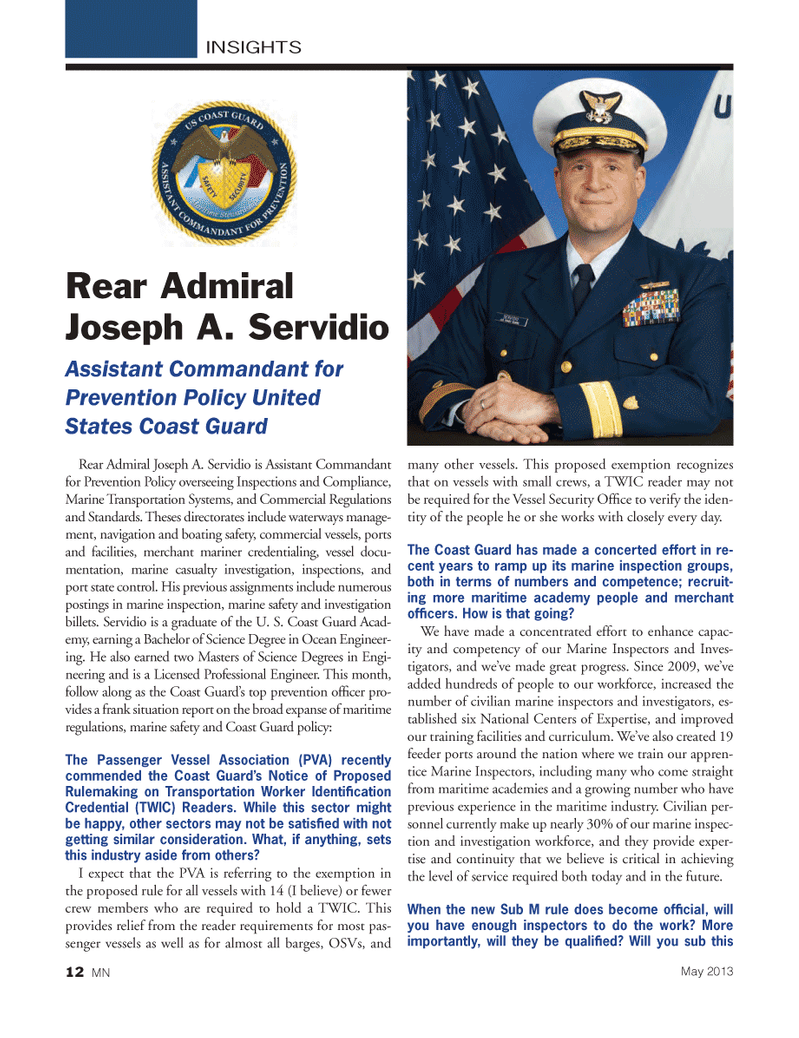
Page 12: of Marine News Magazine (May 2013)
Combat & Patrol Craft Annual
Read this page in Pdf, Flash or Html5 edition of May 2013 Marine News Magazine
Rear Admiral Joseph A. Servidio is Assistant Commandant for Prevention Policy overseeing Inspections and Compliance, Marine Transportation Systems, and Commercial Regulations and Standards. Theses directorates include waterways manage- ment, navigation and boating safety, commercial vessels, ports and facilities, merchant mariner credentialing, vessel docu- mentation, marine casualty investigation, inspections, and port state control. His previous assignments include numerous postings in marine inspection, marine safety and investigation billets. Servidio is a graduate of the U. S. Coast Guard Acad- emy, earning a Bachelor of Science Degree in Ocean Engineer- ing. He also earned two Masters of Science Degrees in Engi- neering and is a Licensed Professional Engineer. This month, follow along as the Coast Guard?s top prevention of cer pro- vides a frank situation report on the broad expanse of maritime regulations, marine safety and Coast Guard policy: The Passenger Vessel Association (PVA) recently commended the Coast Guard?s Notice of Proposed Rulemaking on Transportation Worker Identi cation Credential (TWIC) Readers. While this sector might be happy, other sectors may not be satis ed with not getting similar consideration. What, if anything, sets this industry aside from others? I expect that the PVA is referring to the exemption in the proposed rule for all vessels with 14 (I believe) or fewer crew members who are required to hold a TWIC. This provides relief from the reader requirements for most pas- senger vessels as well as for almost all barges, OSVs, and many other vessels. This proposed exemption recognizes that on vessels with small crews, a TWIC reader may not be required for the Vessel Security Of ce to verify the iden- tity of the people he or she works with closely every day. The Coast Guard has made a concerted effort in re- cent years to ramp up its marine inspection groups, both in terms of numbers and competence; recruit- ing more maritime academy people and merchant of cers. How is that going? We have made a concentrated effort to enhance capac- ity and competency of our Marine Inspectors and Inves- tigators, and we?ve made great progress. Since 2009, we?ve added hundreds of people to our workforce, increased the number of civilian marine inspectors and investigators, es- tablished six National Centers of Expertise, and improved our training facilities and curriculum. We?ve also created 19 feeder ports around the nation where we train our appren- tice Marine Inspectors, including many who come straight from maritime academies and a growing number who have previous experience in the maritime industry. Civilian per- sonnel currently make up nearly 30% of our marine inspec- tion and investigation workforce, and they provide exper- tise and continuity that we believe is critical in achieving the level of service required both today and in the future. When the new Sub M rule does become of cial, will you have enough inspectors to do the work? More importantly, will they be quali ed? Will you sub this INSIGHTSRear Admiral Joseph A. ServidioAssistant Commandant for Prevention Policy United States Coast Guard12 MNMay 2013MN May2013 Layout 1-17.indd 12MN May2013 Layout 1-17.indd 125/3/2013 12:42:51 PM5/3/2013 12:42:51 PM

 11
11

 13
13
